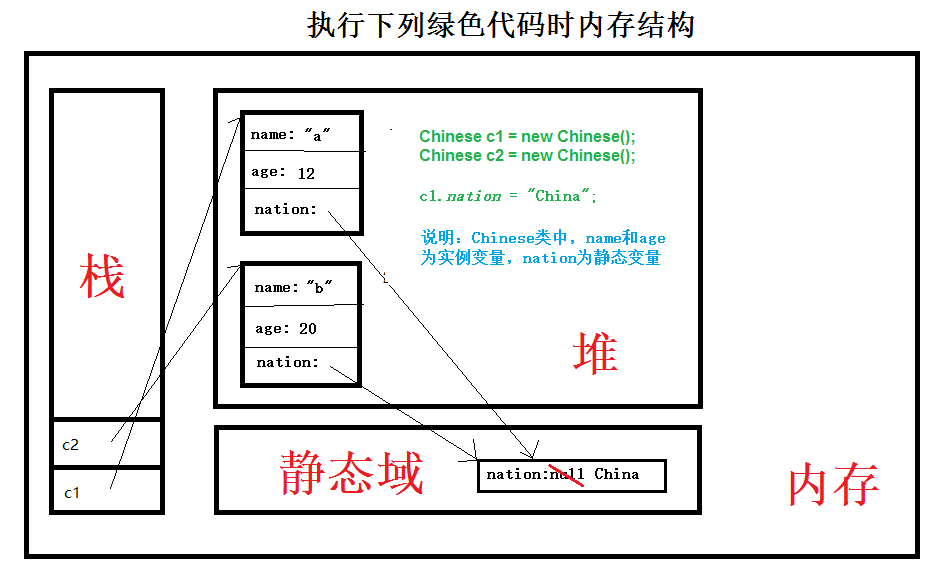静态结构的生命周期要早于非静态结构,同时回收也要晚于非静态结构
一、static修饰属性(类变量)
1、类变量随着类的加载而创建于静态域中,只有一份(内存解析如下)
2、由类创建的所有对象,都共用这一个属性,当其中一个对象对此属性进行修改,其他对象调用时也是修改过的
public void test1(){
Chinese c1 = new Chinese();
Chinese c2 = new Chinese();
//未修改c2的nation属性内容
System.out.println(c2.nation);
//修改c1的nation属性
c1.nation = "China";
//c2的nation也会改变为c1修改的内容
System.out.println(c2.nation);
}
class Chinese{//下面代码均用到此自定义类
//类变量
static String nation;//类为中国人,因此国籍肯定都是中国,可以共用一个属性,声明为static
//实例变量
String name;
int age;
}执行结果
| 变量 | 变量值 |
|---|---|
| c2.nation | “null” |
| c2.nation | “China” |
3、可以不用创建对象而通过 类.类变量 直接调用(用法)
public void test2(){
Chinese.nation = "China";
//Chinese.name = "Lucy";(错误)不能通过类名直接调用实例变量,因为没有创建对象,实例变量也没有被创建
System.out.println(Chinese.nation);
}执行结果:输出China
二、static修饰方法(类方法)
内容与静态属性大体相同
1、类方法 随着类的加载而创建于静态域中,只有一份
2、由类创建的所有对象,都共用这一个方法
3、可以不用创建对象而通过 类.类方法 直接调用
注意:
1. 静态方法内只能调用本类静态属性或静态方法
2. 静态方法里面是不能有this、super等关键字的(因为this代表当前对象,super代表当前对象的父类,而调用静态方法时可能还没有对象)
三、练习
1、计算创建对象的个数
public class TestCircle {
public static void main(String[] args) {
Circle c1 = new Circle(2.1);
Circle c2 = new Circle(6.1);
Circle c3 = new Circle(7.2);
Circle c4 = new Circle(5.8);
System.out.println(Circle.getTotal());
}
}
class Circle{
private double radius;//半径,不同的对象有不同的半径,不能用static修饰
static int total = 0;//记录创建的对象个数
public Circle(double radius) {
this.radius = radius;
total++;//每创建一个对象,就调用一次构造器,类属性total加一
}
public double getRadius() {
return radius;
}
public void setRadius(double radius) {
this.radius = radius;
}
public static int getTotal() {
return total;
}
// total作为记录用途,不要setter方法
// public static void setTotal(int total) {
// Circle.total = total;
// }
}输出结果:4
2、编写一个类实现银行账户的概念,包含的属性有“账号”、“密码”、“存款余额”、“利率”、“最小余额”。测试类中创建4个账户,账号要从1000开始自动生成ID,最后输出储户的信息
public class TestAccount {
public static void main(String[] args) {
Account a1 = new Account("abc123",1000);
Account a2 = new Account("bcd234",2000);
Account a3 = new Account("cde345",5000);
Account a4 = new Account("def456",4000);
System.out.println("a1: " + a1 + "\na2: " + a2 + "\na3: " + a3 + "\na4: " + a4);
}
}
class Account{
private int id;
private String password;
private double balance;//余额
private static double rate = 0.05;//利率
private static double minBalance = 100;//最小余额,所有账户利率和最小余额由银行设置,都是相同的,所以声明为static
private static int init = 1000;//记录当前最后一个生成的ID,初始值为1000
public Account(String password, double balance) {
this.id = init++;//ID自动分配,自动加一
this.password = password;
this.balance = balance;
}
@Override
public String toString() {
return "Account{" +
"id=" + id +
", password='" + password + '\'' +
", balance=" + balance +
'}';
}
}输出结果
a1: Account{id=1000, password=’abc123’, balance=1000.0}
a2: Account{id=1001, password=’bcd234’, balance=2000.0}
a3: Account{id=1002, password=’cde345’, balance=5000.0}
a4: Account{id=1003, password=’def456’, balance=4000.0}
实例总结
- 记录类中所有属性共享的数据。(例二中的rate和minBalance等)
- 可以实现累加的效果,因为静态变量在内存中只有一份,并且生命周期长,随着类回收而回收。(例一中记录创建对象的个数、例二中为每次创建的对象自动分配一个不同的ID)























 3900
3900

 被折叠的 条评论
为什么被折叠?
被折叠的 条评论
为什么被折叠?








